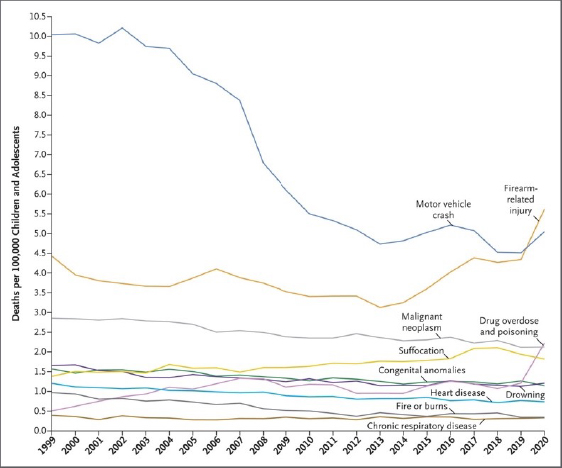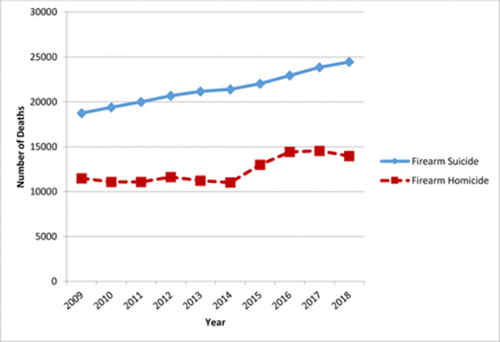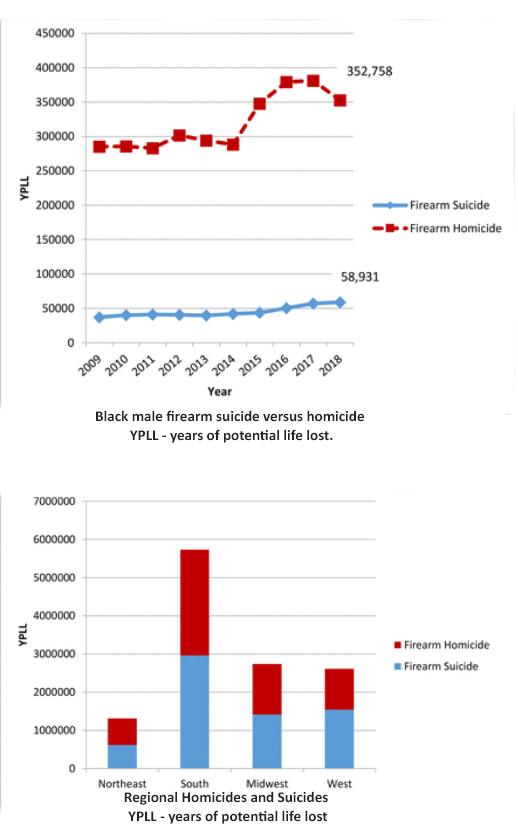First, as an overall review: current federal regulations prohibit the possession of a handgun by anyone younger than 18. Federally licensed firearms dealers may not sell or deliver a handgun or ammunition to anyone under age 21. But those same federal regulations do not provide a minimum age for owning long guns (rifles), allowing long gun sales by unlicensed individuals to minors.
States currently have the right to impose additional restrictive controls, such as background checks, although that may be changing. This summer, the Supreme Court is scheduled to hand down its decision regarding New York’s century-old law, which I discussed here. Supreme Court watchers are optimistic that the court will strike it down.
The real problem
In the wake of recent gun violence, cries for instant solutions dominate the press, each side grabbing whatever factual detritus they can find, regardless of scientific validity, to support their a priori conviction.
 So here are some hard-core truths – along with inconvenient truths underlying sensationalist headlines that, unless acknowledged, will impede the resolution of the issue. To be sure, more research is necessary. As to why we haven’t accumulated more, we need only to refer to the Dickey Amendment, a 1996 amendment to a spending bill that until 2018 disincentivized research on gun safety by prohibiting federal funds to “advocate or promote gun control.”
So here are some hard-core truths – along with inconvenient truths underlying sensationalist headlines that, unless acknowledged, will impede the resolution of the issue. To be sure, more research is necessary. As to why we haven’t accumulated more, we need only to refer to the Dickey Amendment, a 1996 amendment to a spending bill that until 2018 disincentivized research on gun safety by prohibiting federal funds to “advocate or promote gun control.”
The most recent CDC compiled data demonstrates that as of 2020, firearm-related injury became the leading cause of death for children aged 1-19, with most over 14 overtaking car crashes.
The authors of one study attribute this finding in part to stress generated by COVID, failing to note that this trend began in 2017 – long predating COVID.
Of further note is that car-crash injuries have been steadily declining since 1999, suggesting that the strategy used to reduce car-crash trauma might be invoked to solve the gun crisis. Indeed, a commentary in the New England Journal of Medicine makes this point, attributing the car-safety trend to research conducted by The National Highway Traffic Safety Administration. Additionally, these authors claim that firearm safety is one of the few products not regulated by the federal government.
Another recent study in the Journal of Trauma Surgery and Acute Care, which measured fire-arm-related deaths by years of potential life lost (YPLL), also establishes that firearms are replacing crashes as the leading killer. But considering years of life lost does not tell the whole story:
 While homicide deaths surely increased over the last decade (by about 10%), most of the increased fire-arm-related deaths were in suicides (up by 31.5%).
While homicide deaths surely increased over the last decade (by about 10%), most of the increased fire-arm-related deaths were in suicides (up by 31.5%).
Certainly, increased suicides present a public-health crisis. But one is hard-pressed to believe that gun control would have a significant impact on preventing deaths in this category, especially as euthanasia is becoming increasingly liberalized.
This does not mean we shouldn’t focus on the epidemic of mass gun violence, exemplified by recent headlines. However, we need to look behind the superficialities.
 The Trauma Surgery study also demonstrates that the inflection point for homicide’s dramatic increase was 2014, while the trend in suicide remained relatively constant. These trends were even more significant in the Black population.
The Trauma Surgery study also demonstrates that the inflection point for homicide’s dramatic increase was 2014, while the trend in suicide remained relatively constant. These trends were even more significant in the Black population.
Another observation presented by the study is the sharp differential in deaths by geographic locale, with the South boasting rates more than double other regions in the country.
A Solution-Driven versus a Causal Investigation Approach
Before proposing overall solutions, it is crucial to understand the root causes of gun violence.
Here’s a superficial solution-driven approach: Southern states of Texas and Florida have among the loosest gun control laws, and California (with its low gun-related deaths) is amongst the most restrictive – suggesting that more stringent gun control laws are responsible. This is merely a correlative, rather than causal, observation. Nevertheless, these data points do bear further inquiry.
However, what is of greater interest is the startling pivot, apparently nationwide, in 2014 and the spike in 2017. These findings are relatively new and unaccounted for. (Indeed, is anyone even paying attention?). Increased gun deaths began ratcheting up in 2013. The question is, why? It can’t be guns, per se, that account for the increased deaths. They’ve been around far longer than a decade.
Some experts blame the frustrations of increased poverty, discrimination, and glorification of gun violence, crowned in 2022 by the stress of the COVID-19 pandemic, generating high levels of anxiety and depression, and these factors should be investigated. But other deeper problems need exposing.
What could account for the pivots of 2014 and 2017? - The Increasing Banality of Violence
Over the last decade, our society, fueled by all forms of media, has become increasingly addicted to fear and flee and ensuing adrenaline highs, simulated by all forms of hyper-excitement. Media headlines seem to beget more media headlines, and one incident triggers another. The hypothesis of excitement addiction has been studied. One article published in Plos One found that even television violence was predictive of gun violence.
“The positive relation between relative amount of TV violence involving guns and actual homicides due to firearms, especially among youth, is consistent with the hypothesis that entertainment media are contributing to the normative acceptance of guns for violent purposes.”
Regardless of the veneration clearly due the second amendment, one must concede that today's America is far different from America ten years ago, let alone 300 years ago. The question becomes how we accommodate all causal factors while preserving the rudiments of the constitutional vision and acknowledging that the second amendment makes the right to gun ownership absolute.
Core-based Solutions
I suggest that one key measure is preventing guns from getting into the hands of the “wrong” people. Traditional background checks, even when mandated, will not suffice.
We should note that the gun-violence upheaval is contemporaneous with social media's increasing presence and role (as well as the ramped-up excitement addiction). The Uvalde killer was notorious for bullying women online. Many threats went unreported – but those that were went ignored. Perhaps background checks should require a review of a purchaser’s online social media. Perhaps we should encourage greater vigilance and transparency of virtual violence. (Of course, this won’t deter person-to-person sales or the laxity in enforcing gun registration laws already in place, but it’s a start.)
Whether the social media platform regulator is responsible for investigating is outside this article's scope. But when society has evidence of sociopathic tendencies- evidence easily procurable, and we ignore it in favor of the privacy of sociopaths and misfits and the endangerment of the community – then the fault and blame lie with us.
A lesson from Opiate Crisis
The Uvalde gunman reportedly bought two guns and hundreds of rounds of ammunition days before the shootout. Most states have computerized access to opiates, making it more difficult, but not impossible, to stock up and accumulate. If we can do this with drugs, why not ammunition and its essential components, casings, and gunpowder?
Opening Both Eyes
It seems most folks are walking around with one eye closed. Which eye depends entirely on political leanings – close the right eye, and see that gun violence is increasing and easily preventable, or close the left eye and see that the Second Amendment is a pillar of our constitution. One only needs to voice an opinion on this issue- and one’s entire worldview is laid bare, at least for unidimensional thinkers. The problem with one-eyed vision, and by extension, unidimensional thinking, is that one loses perspective.
We really need to start walking around with both eyes open.




